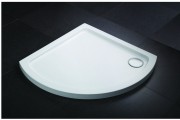
How to Choose the Right Shower Tray for You
Posted on 11. Jan, 2012 by Rob Watson in Advice

Bow Acrylic Tray, from BathEmpire
So, you’ve decided on a new shower enclosure but are slightly confounded by the range of trays that are on offer? Then don’t worry, as this quick guide summons the basic differences, and provides some great tips for installation.
At BathEmpire, we sell two types of shower tray – acrylic and stone resin.
Acrylic
The acrylic trays are manufactured with a central layer of fibreglass resin; onto this, the acrylic mould is attached to finish the tray. They are lightweight, and the style sold at BathEmpire can be installed either level with the floor, or as a raised tray.
The BOW Acrylic Trays sold at BathEmpire are only compatible with the EasyClean Quadrant Shower enclosures (GQ22, GQ23, GQ32).
Stone Resin
The core of these trays feature a thick layer of stone and resin; onto this, an ABS capped acrylic mould is attached to finish the tray. Slightly heavier than acrylic trays, the stone trays can be installed at floor level (standard stone tray) or raised with legs and a smart front panel (EasyPlumb stone tray).
Installation Tips
In the haste and excitement of having a new bathroom delivered, the shower tray is often overlooked. Therefore, don’ t forget to scan over the following tips to avoid making some easy mistakes:
- Even before you sign for the delivery, always check your shower tray and make sure that it is the size and shape that you had ordered.
- The EasyPlumb variety of trays is ideal as they remove the need for building a plinth. Fit the legs onto the underside of the shower tray with the screws provided and adjust to the required height taking into account the slope of the floor, and any existing plumbing.
- When installing any shower tray into adjacent walls, ensure that your chosen shower enclosure will still comfortably fit the remaining length of the tray.
- The shower tray and the connections going to and from the shower must be checked for water flow, tightness and drainage before the final silicone sealant is applied. If you are at all in any doubt, do not hesitate to consult a qualified plumber.
If you would like help or advice in creating your ideal bathroom, feel free to contact the BathEmpire team.
